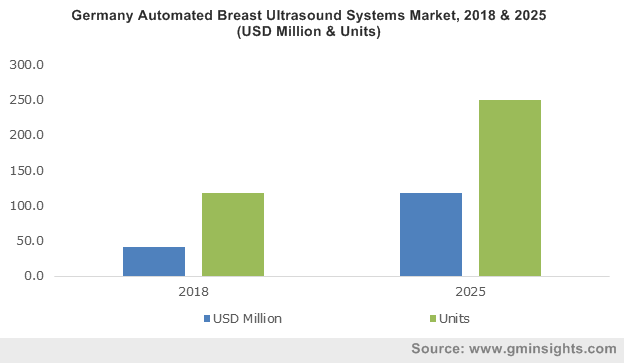Automated breast ultrasound systems market to surpass USD 7 billion by 2024, increased efficiency of breast cancer detection techniques to augment market growth
Publisher : Fractovia | Published Date : 2018-08-30Request Sample
Automated breast ultrasound systems market has lately gained major momentum on account of the increasing investments in R&D programs conducted across a slew of geographies. A recent study published in Norway has indicated conclusively that automated breast ultrasound systems is a more reliable technology for effective breast cancer screening especially for women with mammographically dense breast tissue. Incidentally, previous research already made it evident that women with mammographically dense breasts run a higher risk of developing breast cancer that goes undetected than women with non-dense breasts.
U.S. Automated Breast Ultrasound Systems Market, By Product, 2013 – 2024 (USD Million)

To be precise, prior research clarifies that the overlapping of dense breast tissue and mammograms causes a concealing effect, causing cancerous cells to somewhat remain unobserved. The recall rate, that is, the rate of women being called back to undergo additional examination as the mammographic findings were suspicious, is also higher for women with dense breasts. The study inferred that recall rate for women with dense breasts is 3.6% , while that for women with non-dense breasts is 2.7%. In essence, the commercialization scope of automated breast ultrasound systems industry seems to be quite lucrative, given that the technology is highly indispensable for women with mammographically dense breast tissue.
Breast cancer has been recognized as the most common type of cancer among women across the world. The World Cancer Research Fund International conducted a study in 2012 and found that around 1.7 million cases of breast cancer were diagnosed worldwide – representing around 25% of all cancers in women. Breast cancer is also the fifth most common cause of death among women. Awareness about the disease and the increase in early diagnosis, especially in countries with easier access to medical care, has improved survival rates for breast cancer patients across the world. As the chances of cancer doubles during each decade before menopause, women over 40 are encouraged to routinely screen for breast cancer, providing a viable growth avenue for automated breast ultrasound systems market.
Breast mammography has become a standard for breast cancer diagnosis and an indispensable tool for women’s healthcare helping in the early diagnosis of breast cancer. Doctors have reported observing a 30% reduction in breast cancer related deaths due to the implementation of routine breast cancer screening. In spite of such positive statistics, the benefits and efficiency of mammography are often called into question. It has been found that mammography alone cannot be said to be effective for all women in the population. Though the sensitivity of mammography for fatty breast tissue tends to be around 97%, in case of dense breasts this figure dramatically falls to 47%. With mammography touted to miss 37% to 70% of breast cancers within the dense breasted female population, automated breast ultrasound systems have gained prominence. In consequence, this has emerged as a pivotal driving factor for automated breast ultrasound systems market.
Since mammography fails to effectively detect breast cancer in women with dense breasts which in itself is an independent risk factor for developing cancer, legislations have been passed by governments to notify women of the dense breast tissue condition and educate them about the need to undergo additional tests besides mammography to safely diagnose the presence or absence of cancer cells. Supplemental imaging tests such as breast computed tomography (CT), breast magnetic resonance imaging (MRI) and contrast-enhanced mammography have also become popular. However, research and development in ultrasound has demonstrated that it is a technology which has proved to be highly beneficial for breast diagnostic imaging.
Automated breast ultrasound systems involve the use of passage of high-frequency sound waves through the breast that provide a 3D image of the entire breast. These 3D images are more efficient in detecting cancer cells in women with dense breast tissue and allow radiologists to access multiple angles of examination. Automated breast ultrasound systems also last for a shorter duration of time as compared to traditional ultrasounds with some systems performing a bilateral exam in half the time taken by ultrasounds. Operator dependency is also reduced as the transducer used in ABUS automatically scans the breast. Driven by the ease of handling and high efficiency of the product, automated breast ultrasound systems market has gained considerable traction in the overall healthcare space.
An automated breast ultrasound system’s sensitivity which is around 97%, when used in combination with mammography has proved to be a technology that can be incomparably beneficial as a screening tool for women within the dense breasted female population. It is still a relatively new technology, owing to which numerous players in the automated breast ultrasound systems market are competing with each other to innovate and improve the technology.
A slight deterrent in the unbridled growth of the automated breast ultrasound systems market may be contributed to the lack of trained radiologists. While the technology will reduce the requirement of an accredited operator, the need for formally trained radiologists will increase as many radiologists are not familiar with volumetric 3D images. However, steps are being taken to overcome plausible restraints to the growth of this industry. As per estimates, automated breast ultrasound systems market size is expected to register a CAGR of 9% over 2018-2024.